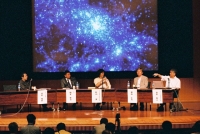 |
 |
|||||||||||||
|
|||||||||||||
|
|||||||||||||
|
On the first day of a three-day weekend with a Japanese national holiday, Day of the Sea, about 300 people changed their destination from seaside to science. They enjoyed talks on cool science on a hot Saturday afternoon in Tokyo at a symposium called “Denshi-koraidah ga toku ucyu sousei no puzzle (Solving the puzzle of the universe with electron-positron colliders),” organised by KEK. The symposium introduced the science to be delivered by future electron-positron colliders to a non-scientific audience. The symposium was a two-part event. The first part consisted of talks by three top-notch scientists – Hitoshi Murayama, Director General of Institute for the Physics and Mathematics of the Universe (IPMU), Shoken Miyama, Director General of the National Astronomical Observatory of Japan, and Atsuto Suzuki, Director General of KEK. The second part was a panel discussion with those three scientists and Shinji Kimoto, a science-fiction novelist who wrote the award-winning novel 'Kamisama no Puzzle', and was moderated by Shigehiko Nakajima, Editor-in-Chief of Nikkei Science Magazine, the Japanese edition of Scientific American. “KEK needs to improve the visibility of Japanese R&D activities on the electron-positron collider,” said Masa Yamauchi, KEK's spokesperson for the Belle collaboration and member of the Funding Agencies for Large Colliders (FALC), who was one of two main organisers of the symposium. “The main motive to have this symposium is to promote KEK's road map, especially our strategy on electron-positron colliders, with upgrading the KEKB accelerator and realising the ILC project,” he explained. According to him, KEK has not been very proactive in outreach activities towards the public at large. Because of the nature of its establishment, KEK's outreach activities are mainly aimed at students in science and engineering majors. “I don't think that is enough,” said Mitsuaki Nozaki, the Regional Director for Asia of the ILC Global Design Effort, and the other main organiser. “It is not only to fulfil our responsibility as scientists to communicate with tax payers, we also would like to share the fun of science with many people,” he said. Murayama explained how particle physics relates to the fundamental questions like "how was the Universe born?" His easy-to-understand talk was very popular among the audience. “Now I want to study physics again,” commented one member of the audience. Miyama fascinated the audience talking about astrophysics with beautiful and interesting images and movies. Suzuki then introduced KEK's road map and what accelerators can do to solve the mysteries of the Universe. Theory, experiment, and observation - it was a rare opportunity to listen to three different viewpoints on one same question. “Listening to three talks, I thought that real science is much more fiction-like than the science fiction novel,” said Kimoto in the panel discussion, and many seemed to feel the same way. “Each talk was too short and I wanted to hear more,” many people in the audience expressed their demand to have another opportunity like this. “I am a bit surprised to see so many positive reactions and big demand for the symposium of this kind,” said Nozaki. KEK is planning to have another symposium later this year. -- Rika Takahashi |
|||||||||||||
| © International Linear Collider |
